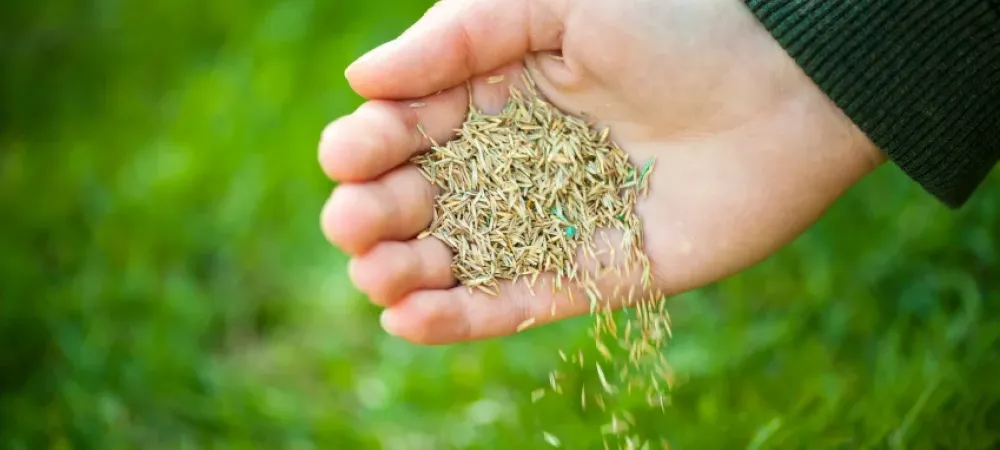The Benefits of Aeration and Overseeding

To get that dream lawn that you've always wanted, you need to do more than just practice proper mowing, fertilizing, and weed control. All of these things won't benefit your lawn if your soil is compact and is in need of aeration. Learn to recognize the signs of compacted soil and how aeration can help your lawn thrive.
What Is Lawn Aeration?
Lawn aeration is the process of creating small holes in your lawn to allow air, water, and nutrients to penetrate the grass roots. This helps the roots grow stronger and deeper, resulting in a more resilient, healthier lawn.
Core Aeration vs Liquid Aeration
There are two main types of lawn aeration: core aeration and liquid aeration.
- Core aeration involves using a machine to remove small cores of soil from your lawn. This helps to reduce compaction and improve drainage. It also allows air and nutrients to reach the grassroots more easily.
- Liquid aeration, on the other hand, uses a solution that is injected into the soil. This solution contains nitrogen, which helps to encourage new growth. Liquid aeration is less invasive than core aeration and is often used on delicate or sensitive lawns.
What Are The Benefits of Aeration?
Aeration has immediate and long-lasting benefits that improve the overall health and appearance of your landscape, including:
Some common benefits of lawn aeration include:
- Improving soil quality
- Reducing compaction
- Enhancing drainage and increased water absorption
- Increasing oxygen levels in the soil
- Stimulating new growth
- Reducing thatch buildup
- Improving heat and drought tolerance
- Encouraging deeper root growth
Not only can aeration help your grass, but it will create a thicker lawn, which in turn can prevent weeds from taking over. Enhancing the drainage can also reduce standing water, which is a common breeding ground for mosquitoes.
What Is Overseeding?
Overseeding is the process of planting grass seed over an existing lawn. This is usually done to improve the density or quality of the turf. Overseeding can also help to fill in bare patches, reduce thatch buildup, and improve drainage.
While you can add more seeds of your existing type of grass, overseeding is usually done with different strains of grass than your current lawn, as this can make your yard more resistant to lawn pests, drought, and lawn disease.
Check out our blog to learn more about the best types of grass for Tennessee yards.
Benefits of Pairing Aeration and Overseeding
Aeration and overseeding are often done together because they complement each other so well. Overseeding immediately after aeration allows the new seedlings easy access to the soil, which improves seed germination rates. The holes left behind by aeration also provide a perfect environment for seedlings to take root and thrive. By doing both aeration and overseeding, you will give your lawn a major boost in terms of density, quality, and health.
Keep Lawn Healthy With Services From 4-EverGreen
At 4-EverGreen our team of experienced Jackson lawn care technicians can help you achieve a healthy, green lawn by offering a variety of lawn services, including aeration and overseeding services. With offices in Tennessee and Missouri, we can create a personalized treatment plan that encourages grass growth and will give you a beautiful lawn.
FAQ About Aeration and Overseeding
To help you achieve a healthy lawn, here are some aspects to consider.
Should I Aerate My Lawn?
One of the most common questions from homeowners is how to determine if they should be aerating their lawn. Here are some indicators that your lawn is a good candidate for aeration:
- Children, pets, or other types of foot traffic are common. Constant traffic over years can cause soil compaction.
- The lawn was established as part of a newly constructed home. Construction equipment can cause soil compaction.
- Water runs off or pools in areas of your yard. This could be caused by thatch as well. Pooling water can compact your lawn, and attract fungus, disease-carrying mosquitoes, and other pests.
- Use a shovel to check the thatch layer of your grass. If it is thicker than a half-inch then aeration is recommended.
- Brown patches or weak-looking grass.
How Do I Know If My Soil Is Compact?
There are a few different methods of finding out if your soil is compact. If you are ready to test it out yourself, go grab yourself a screwdriver. Taking a small household tool like a screwdriver and pushing it into your turf in a few different spots to see how far down you get is a great way to identify soil that is too tough to push through. If your tool doesn’t make it more than a few centimeters down without excessive force, then you should assume this is a good sign that you have compacted soil.
If you aren’t someone who wants to get dirty, there are a few other ways that you can tell if your soil is compact. Some of these signs of compact soil include:
- Excess Thatch—Thatch is a buildup of organic debris on your lawn. Some organic matter on your lawn is inevitable and even good for it, however, if it is constantly being built up, it can cause issues.
- Pooling Water—If you know you have a proper irrigation system going, you are going to want to notice whether or not water is pooling up around the edges and getting on the cement. This means your turf is not absorbing the water you’re giving it.
- Thinning Grass—This one is more of a result rather than a symptom because, without nutrients, your turf is not going to present as full and luscious.
How To Loosen Compacted Soil
The best way to loosen compacted soil is through aeration, which includes using a mechanical aerator to pull up little pieces of your soil about three inches deep. This will relieve some of the pressure from your soil, allowing better air- and water flow. The parts of your lawn that are pulled up are left on your lawn and broken down to create a natural mulch mixture, which encourages the regrowth of your lawn.
When Is The Best Time To Aerate?
The best time to aerate depends on where you live and your grass type.
- Cool-season grasses, such as ryegrass, Kentucky bluegrass, and fescues, should be aerated in the early spring or fall.
- Warm-season grasses, such as bermudagrass, centipede grass, St. Augustine, or zoysia grass, should be aerated in the late spring or early summer.
Aeration should be done during the growing season of your grass, as this will allow your turf to quickly recover.
When Is The Best Time To Overseed My Lawn?
The best time to overseed your lawn is in the fall when the weather is cooler and the seed has a better chance of germinating. Overseeding in the spring can also be successful, but you may need to water more frequently to keep the seedlings alive during hot, dry weather.
How Often Should I Aerate My Lawn?
Most lawns only need to be aerated once every one to three years. If you have clay soil or your lawn gets a lot of foot traffic, you may need to aerate more frequently. Conversely, if you have sandy soil or your lawn isn't used much, you may be able to go longer between aerations. The best way to determine how often to aerate is to consult with a lawn care professional or ask your local nursery or garden center for advice.
Should I Fertilize After Aeration?
Fertilizing your lawn after aeration can help promote new growth and fill in any bare patches. If you're planning to fertilize, wait at least a week after aerating so that the holes have time to heal. Then, apply a slow-release fertilizer according to the manufacturer's instructions.
